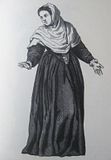GREEK RENAISSANCE WOMEN
Cause I love Greece, and I love the Renaissance style... It should however be noted that what was considered Greek in the 16th century has switched borders probably several times. Greece as such didn't exist, but Greek as a people, language and culture did. Most of it was under the Ottoman empire; some also under Venice and other European powers. Most of the depictions are from areas where Venice was involved, either as Venetian colonies, or areas Venice traded with. I'll try and point it out in each picture. Note also that these are 19th century remakes of Vecellio's 1590 originals and others, some details might be Victorian interpretations.


Greek women living in areas dominated by the Republic of Venice. You can clearly tell their dresses are Venetian in style, but the headdrapes and accessories have a more exotic flair. Dark hair is also rare for true Venetian ladies. The latter woman is from Candia, modern Crete. Crete was under Venetian powers in more or less four centuries, from the 13th to the 17th century.

Greek woman of Rhodes. The island was formerly under the knights of Rhodes, which were the pre-runners of the knights of Malta. The reason why they ended up on Malta in 1530 was that they, after several attempts, were expelled from Rhodos by the Ottoman sultan Suleiman in 1522. Charles V then granted them Malta, and they became an important Catholic institution.


Greek women of Pera, modern Beyoğlu in the European part of Turkey. The former is described as a "woman of Pera", the latter as a bride. Venice had interests in Galata, a neighborhood in Pera/Beyoğlu, which might be why Vecellio knew of the style of dress here.


Greek woman of Mytilene, modern day Lesvos near Turkey, and Greek woman of Chios, the neighbor island of Lesvos. Italy did trades with both islands, especially fabrics and furs, but also wine and food. They also served as safe harbors.




The two first shows a Thessalonikan bride and Macedonian matron, then a woman of Thessaly (modern province of northern Greece). The latter shows a man of Monastir (Ottoman province covering much of northern Greece) and a woman from Thessaloniki (here referred to as Saloniki). In the 1420s the head of Thessaloniki turned to Venice for help against the Ottomans. The Ottomans did however take the city in 1430.
Macedonia in this context mean the historical northern Greek province of Macedonia. An ex-Yugoslavian state formerly a part of the Greek region has taken the same name, while the modern Greek province is "next door". Huge clinch there... Which is why the ex-Yugoslavian state officially bears the name F.Y.R.O.M - Former Yugoslavian Republic of Macedonia. Thessaloniki is the capital of Greek Macedonia.